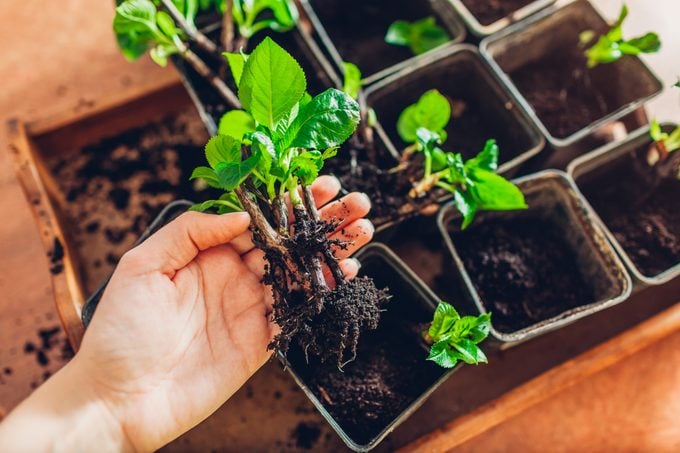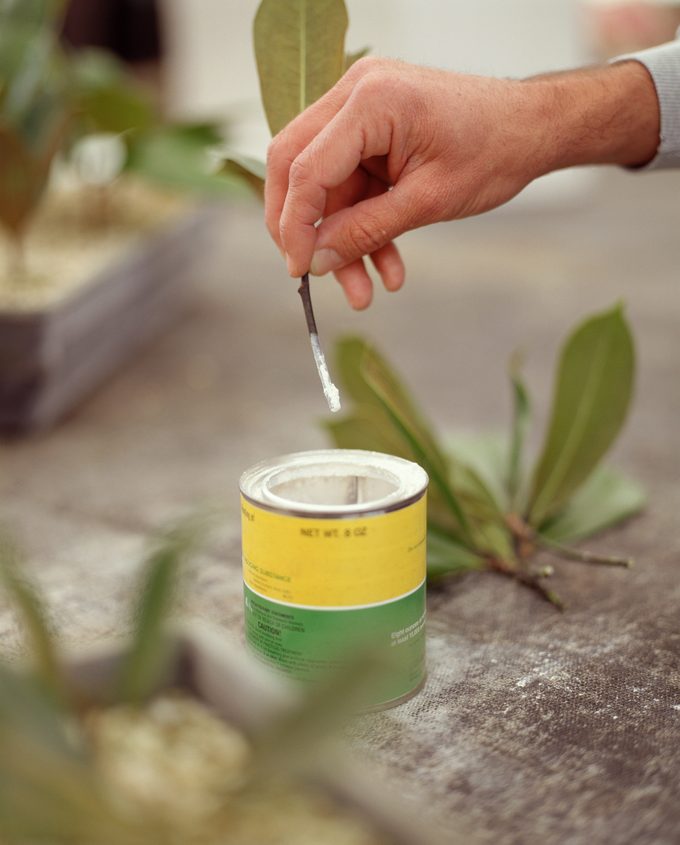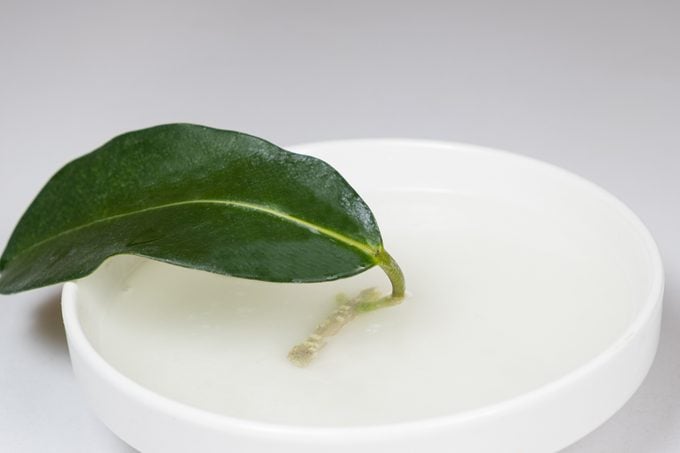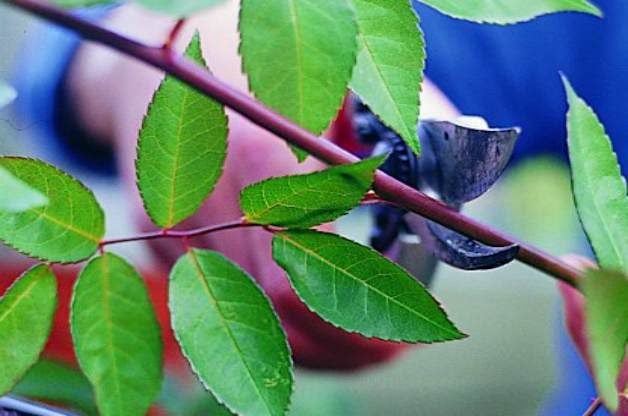How to Root Woody Plant Cuttings
Updated: Jan. 24, 2024
Learn the basics for growing new rooted woody plant cuttings, including what types of plants you should and should not propagate.
On This Page
Why You Should Make Plant Cuttings

Growing plants from cuttings is a great way to expand—or share—the beauty of any garden. Perhaps you’d like to preserve a flower with family history, increase your collection of favorite blooms or reproduce that hard-to-find plant. Most gardeners have had success rooting leafy plants like coleus or philodendron. A short stem with leaves will quickly form roots in water, potting mix or vermiculite—and then you are well on your way to a full-sized plant.
The same does not hold true for trees and shrubs, however. With these woody plants, you’ll need to pay more attention to timing and the type of cutting you take. And these factors will vary depending on the type of plant. But with a little practice, you’ll soon know how to root cuttings of woody plants like roses, lilacs, forsythias and spireas. The extra effort will be worth it.
Check out the top 10 plants to grow from plant cuttings.
Types of Rooted Woody Plant Cuttings

There are several types of rooted plant cuttings you can use to propagate new trees and shrubs. Learn more about plant propagation to multiply your plants for free.
Hardwood plant cuttings
These are the key to starting plants like roses, forsythia, privet, olive, wisteria, spirea, hemlock and many other deciduous and needled trees and shrubs.
During the dormant season, which is late fall or winter, remove a 4- to 8-inch stem piece of the previous season’s growth that contains two nodes—the place where leaves attach. Pack the cuttings in peat moss or sawdust and store them in a cool dark place until spring. As the weather warms, stick the cuttings—with the end that was closest to the roots down-in a flat of moist vermiculite, perlite or sand. To increase the success for these types of cuttings, or any others, dip the end in rooting hormone first.
Semi-hardwood plant cuttings
Summer is the time to take semi-hardwood cuttings—the new growth that’s starting to harden up and mature. This works for varieties like holly, azaleas, pittosporum, euonymus, citrus, olive and other broadleaf evergreens and deciduous trees and shrubs.
Take 3- to 6-inch cuttings in the morning when the stems are firm and full of moisture. Remove the lower leaves and cut the remaining leaves in half to reduce moisture loss.
Then root semi-hardwood cuttings in moist vermiculite, perlite or sand in a shaded and humid location. Loosely cover the container with plastic to increase the humidity and monitor the temperature to prevent overheating.
Softwood cuttings
Softwood cuttings from tender new growth are another way to propagate plants like lilacs, roses, forsythias, magnolias, weigela, spireas and fruit trees.
Take 3- to 5-inch cuttings early in the day and plant them right away for the best results. Root in a warm and moist rooting medium in a humid location that’s out of direct sun.
Expert Tips for Making and Rooting Plant Cuttings

- It’s best to take cuttings from recently watered plants. The cuttings will be healthier when taken from plants that are full of moisture.
- Make sure you have a clean, sharp knife or a good pair of pruning shears handy to make the cuts.
- Take cuttings only from healthy plants. Make sure the parent plants are disease- and pest-free. Early morning is the best time to take cuttings.
- Not all plant cuttings will root at the same speed, so if one plant takes 10 days and another takes 20 days, don’t be alarmed.
- Be prepared for this process to fail from time to time. And don’t be afraid to experiment with other plants, just to see what happens.
No matter what kind of cuttings you’re using, once they’ve rooted, you can treat them like bare-root plants and add them to your garden. Or, move them to a large container filled with well-draining potting mix. This allows the plants to develop stronger root systems before transplanting.
Learn how to propagate succulents.
Pay Attention to Patents

Before you take a cutting of that fancy new rose or lilac, it’s important to understand some of the laws related to the plant world.
Many new varieties are patented. This means you cannot take a cutting from an existing plant to start a new one without the permission of the patent owner. This right is reserved for the company that spent time and money developing the new or unusual variety. If this is the case, a close look at the tag or growing information will reveal a patent number or note that the patent is pending.
Patents are good for about 20 years. After that, you are free to take cuttings and start your own plants. Although it may seem like an inconvenience, remember that respecting the patents helps support those who work to introduce new plants for us to enjoy.
When checking the tag, you also may see ® or copyright symbols. You can take cuttings and plant these varieties in your garden, as long as they are not patented.
If all this sounds too confusing, don’t be intimidated. There are plenty of old family favorites and traditional garden beauties that aren’t protected—and these make great candidates to grow from cuttings.
As you begin trying to grow trees and shrubs from cuttings, I do have some last words of wisdom: Professionals often spend years perfecting this process, so don’t be disappointed if your cuttings don’t root right away. Just keep trying, and soon you should have new plants to show off for your efforts.
Next, get expert tips on how and when to prune lilacs.
Why Trust Us
For nearly 30 years, Birds & Blooms, a Trusted Media Brand, has been inspiring readers to have a lifelong love of birding, gardening and nature. We are the #1 bird and garden magazine in North America and a trusted online resource for over 15 million outdoor enthusiasts annually. Our library of thousands of informative articles and how-tos has been written by trusted journalists and fact-checked by bird and garden experts for accuracy. In addition to our staff of experienced gardeners and bird-watchers, we hire individuals who have years of education and hands-on experience with birding, bird feeding, gardening, butterflies, bugs and more. Learn more about Birds & Blooms, our field editor program, and our submission guidelines.
